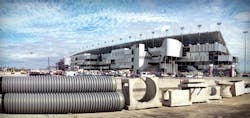Storm Drainage: To the Finish Line
About the author: Tori Durliat is director of marketing for ADS. Durliat can be reached at [email protected].
As the Daytona Speedway in Daytona Beach, Fla., continues its $400 million construction project, one key part was the improvement to nearby roads that would enable the smooth flow of some 100,000 spectators before and after a race or event. Existing storm water ditches were replaced by a closed drainage system with wide sidewalks on top.
Recently completed in June 2015, the new storm water drainage system is part of a 1.4-mile design-build project on U.S. Route 92—International Speedway Boulevard between Williamson Boulevard to Midway Avenue. For the ditch infill, more than 30,000 ln ft of large-diameter polyolefin pipe was used, in diameters ranging from 18 to 48 in.
“This was a design-build job, so we could use the ADS HP pipe,” said Chad Hazen, manager, Hazen Construction LLC. “Essentially, the job is going from storm box to storm box to collect all that drain off from the road. On International Speedway Boulevard there were two gigantic ditches on both sides that are right in the way of pedestrians. You have the entire right-of-way effectively being a ditch with a little tiny sidewalk. When you have 150,000 race fans leave after the race, it’s a lot of bottleneck congestion. So they decided to pipe the ditches to create a 10-ft-wide sidewalk on both sides.
“The idea was that the roadway had closed-flue inlets—there are 132 of them that allowed the water to drain off the road through this concrete flume and then it just dumped into the ditch. So the question was how do we capture all that runoff and get it into the trunkline. That trunkline ... the pipe going into the ditch ... was anywhere from 18 in. all the way up to 48 in., the biggest pipe we laid on this job. So when you’re weighing that and you’re collecting all the rain off the road, how do you get from the main line to the flume up there? Basically it was an 18-in. pipe that would connect into that flume, which would then allow all the runoff of the water to make it to the trunk line.”
Hazen went on to point out that the biggest advantage was that this pipe is rigid, which is good because Florida DOT projects require laser profiling and checking for joint gaps, cracks and ovality of the pipe.
With laser profiling, the FDOT could say that a pipe is not good and thus needs repair.
“ADS came up with this product, which is very rigid, so it never goes out of round. We laser profiled everything on this job and only had one issue that was self-inflicted ... not a pipe problem.”
“The other advantage is that the pipe easily goes home and you don’t have a joint gap because of the amount you can insert into the bell end. It is so great that even if you don’t home it up all the way, FDOT will still recognize it as a watertight joint. In our experience with laser profiling concrete pipe, you find a lot of gap and hairline crack issues and you spend more time repairing the pipe than what you really should. With this pipe, we had none of those issues,” Hazen said.
Pipe Specs
The HP Storm is a polypropylene pipe for gravity-flow storm drainage applications. The smooth interior wall offers additional strength as well as effective flow. It meets ASTM F2736, ASTM F2881 and AASHTO M330 for the respective diameters. This polypropylene pipe also is approved for use by the Army Corps of Engineers for storm drainage applications under Section 33 40 00 of the Unified Facilities Guide Specifications. The pipe has a patented extended, reinforced bell with a polymer composite band and dual gaskets that add an additional factor of safety within each joint. The HP Storm joint performance meets or exceeds the 10.8 psi laboratory performance standards per ASTM D3212 requirements.
On the Daytona job, the pipe was buried with cover ranging from 3 to 9 ft of native soil. “We had five crews, with about five in each working at the peak of the job laying different lines at five different locations, which all connected at the end,” Hazen said.
On Bayless Boulevard, the water ultimately drains into a 5-by-10-ft box culvert, goes underneath the road and then into a canal—the Bayless waterway—that eventually goes under I-95 and ultimately ends up miles away in the Tomoka River.
To connect the laterals to the trunkline, InsertaTee units from ADS were used. “We generally use a box, but using the Tees was approved by everybody, which saved some money and made it possible for the job to be installed a lot more quickly than using pre-cast structures,” Hazen said. “We had used the Tees on other smaller projects with HP, but this is the biggest to date. There was a lot of pipe—more than 5.5 miles—and about 134 InsertaTees from 24 by 18 to 48 by 18 in. They’re all good products and we’re very pleased with all of it.”
Download: Here
